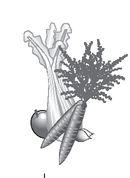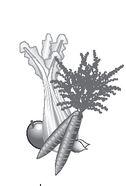Chapter21
Pests, Diseases, and Blight
In This Chapter
• Your garden’s worst nightmares
• Which insects like what plants?
• Natural and organic techniques for pest control
• Deterring pests
No matter how meticulous you are about planning, planting, and maintaining your garden, you’re going to have problems with pests. It’s inevitable. And it can be frustrating.
In this chapter, I introduce you to some of the most common insect pests, along with a few of the predatory insects that eat them. We also look at some insecticides and pesticides that are effective against the invaders. We consider some organic or natural approaches as well. And along the way, we figure out what to do with warm-blooded pests who can make a mess of the garden.
And before we proceed, I’d like to suggest that you use common sense when dealing with pests in the garden. Most experienced gardeners put up with a certain amount of damage. They accept the fact that there will be losses and that some produce will be less than perfect. The most successful gardeners are smart enough to plant more of the most troublesome things to get at least a small harvest, or to give up that item altogether.
Bad Bugs
Maybe I should have called this section “Icky Insects” because educated gardeners try not to use the word bug—kind of like dirt. Anyway, the number and diversity of insects that can cause damage to a garden is staggering. Different insects are sometimes more of a problem in different parts of the country and certainly create difficulties with some plants more than others.
The following table lists some of the most common insect pests and their favorite meals.
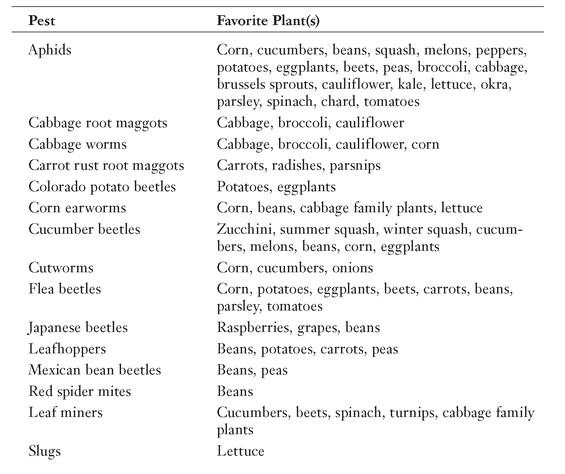
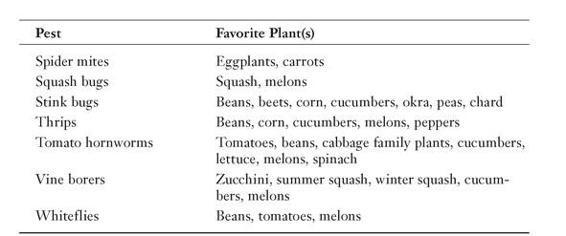
As you can see, many insects are a problem for more than one type of plant. Frequently, the problems run in families. The Brassicas have trouble with cabbage root maggots and cabbage worms. Squash and cucumbers, which are members of the Cucurbita family, are troubled by cucumber beetles and vine borers. When you know how plants are related to each other, it can help you deal with their potential pests.
Food for Thought
One of the best sources for information on insect pests is a publication from the Texas A&M University Agricultural Extension Service called Managing Insect and Mite Pests in Vegetable Gardens. Find it online at insects.tamu.edu/extension/ bulletins/b-1300.html. This thorough document contains descriptions, including drawings, of a host of pests; lists of plants and the insects that attack them; and the pesticides that will kill these insects.
Although no garden will be completely pest-free, it is possible to keep the damage to a minimum. The best defense is good horticultural hygiene. This means removing any insects found on seedlings before transplanting, thorough and regular weeding, removal of damaged leaves and other plant parts, and harvesting on time so rotting fruits don’t attract more insects.
Also, keep in mind that healthy plants are more able to withstand the occasional insect attack. Conversely, plants that are compromised because of poor soil, lack of water, or too much or too little fertilizer will be more susceptible.
Good Bugs
I know people who find all insects disgusting and frightening. That’s not a good attitude for gardeners. Some insects are absolutely essential for the very survival of plant species (especially the pollinators), and others spend their entire lives devouring the insects that can cause so much damage in the garden (the predators) or helping keep your soil in top shape (the aerators).
The following table offers a list of the good bugs. You can make friends with them if you want. (Look for illustrations of many of these pollinator and predator insects at www.ca.uky.edu/agripedia/agmania/insectid/BENEF.asp.)
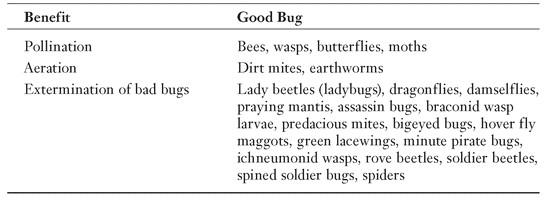
Food for Thought
As helpful as praying mantis are at keeping aphids and other pests n check, they have voracious appetites and will be just as happy chomping on beneficial insects like ladybugs or lacewings. Praying mantis can deliver a nasty bite to unsuspecting humans as well. I found that out one day when a granddaddy mantis attached himself to my ankle. Ouch!
As you can see, many insects are beneficial to your garden, and unless you’ve studied them, you might have difficulty telling a good bug from a bad one. That’s why it’s just not a good idea to use insecticides and pesticides indiscriminately. If you just go out and spray like crazy, you’ll wind up killing every insect out there.
Take bees, for example. Bees are essential pollinators, but they’re in trouble, with as much as one third of all honey bees in the United States having disappeared due to colony collapse disorder. Recent scientific studies may have identified the culprit—a class of pesticides called neonicotinoids. Even if you’re inclined to use commercial pesticides, try to avoid products that contain neonicotinoids. Also, never apply pesticides when bees are around. They work during the day, so if you must spray with a pesticide, do it in the very early morning or late in the day after bees have returned to their hives. Better yet, look for products that aren’t toxic to bees.
If you think you would like more bees living in or near your garden, think about offering to host a beehive on your property. Many professional (and amateur) beekeepers are looking for good homes for their beehives. You’ll have to promise not to use chemicals that are toxic to bees, and you may need to have the support of neighbors to do the same. But your garden will love it, and you’ll probably be treated to some free honey. Get in touch with your local county extension office for a list of area apiarists (beekeepers).
Insecticides and Pesticides
Insecticides and pesticides are products that kill insects and other pests. To clarify, pesticides are products that kill pests; not all insects are pests and not all pests are insects.
Hundreds of chemical compounds are used as pesticides, some utterly lethal to everything and anything they touch. Their selection and use is too important and complicated an issue to be covered adequately in this small space. So before you use any commercial pesticide, read the labels carefully and thoroughly and follow the directions exactly. Be sure to identify the insects that are causing the damage so you can pinpoint the insecticide you need to use. If you have any doubts, consult your county extension office. The sales staff at garden centers, nurseries, and hardware stores won’t necessarily know enough to help you make the right choices.
When you do elect to use a pesticide to control an infestation, make a thorough application, especially to the undersides of the leaves. Liquid pesticides are generally easier to apply than powders.
Garden Guru Says
A few pesticides are available that have a relatively low environmental impact, including insecticidal soaps and vegetable oil-based sprays that use pyrethrins and other plant extracts to kill aphids, mites, whiteflies, thrips, leafhoppers, and a few other pests. Milky spore, a bacterium, can be used against Japanese beetles, and iron phosphate-based baits kill slugs.
The Argument for Organic
Many gardeners grow their own food expressly to reduce their exposure to pesticides. Naturally, these gardeners want to take an organic, or at least Earth-friendly, approach to dealing with insect pests. A number of options are available, including barriers, natural repellents, and hand removing.
Prof. Price’s Pointers
Integrated pest management is an approach to disease and insect control that uses environment-friendly methods that reduce the use of chemical agents while maintaining and promoting a healthy garden. Other natural ways to prevent disease and pest infestation include mechanical and barrier controls, good garden hygiene, crop rotation, the use of resistant plant varieties, adequate irrigation, and good soil preparation.
Floating Row Covers
Floating row covers are one of the best barrier methods for pest control in the edible garden. Also called agricultural fleece, floating row covers are lengths of lightweight fabric (usually spunbonded polyester) that are draped like a blanket over rows of plants. The fabric allows sun and water to penetrate and even provides some frost protection, but it keeps out insects. The covers are held in place by burying the edges in soil.
Food for Thought
Just what we need, more plastic, right? But the protection against insects that polyester covers provide makes using plastic seem like a reasonable trade-off. Good-quality floating row covers, if used and stored with care, can last many asons. And perhaps, one day, someone will figure out how to make them out of recycled materials.
Floating row covers are usually installed at seed planting or transplanting time and kept on during the early stages of growth. As soon as the first flowers appear, the row covers must be removed or pollinating insects will be unable to do their work.
Floating row covers are particularly effective for protecting against the following:
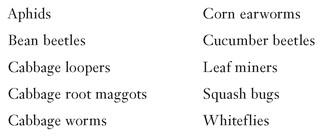
If the soil under the row covers is infested with plant-eating insects, the row covers might do more harm than good because you won’t be able to see much of the damage until it’s too late. Rotating crops every year helps prevent soil infestation.
Cutworm Collars and Maggot Mats
Cutworm collars are insect barriers I first learned about back in the late 1980s from The Victory Garden Kids’ Book. You can make your own or buy commercial versions.
The collars form a circular barrier around the stem that prevents nasty chomping or boring insects from climbing up the stems of young seedlings. You can use a paper cup with the bottom half cut off for a small collar. Or use an empty tomato sauce can with the bottom removed. Plastic soda bottles and milk cartons with the bottoms and the narrow parts cut off also make effective collars.
The collars work best on young seedlings, but you can make larger versions. Put the collar in place when you plant the seed or seedling, and leave it there as long as it doesn’t interfere with the growth of the plant.
Maggot mats are like little carpets around the stem of young plants that prevent cabbage maggot flies from laying their eggs in the soil near the young plants. The Victory Garden Kids’ Book gardeners used actual pieces of leftover carpet to make the maggot mats. The carpet is cut into 5-inch squares, and a slit is made from one edge to the center with a small hole right at the center. When the seedling is planted, the maggot mat goes on top of the soil around the stem and then the slit is taped closed.
If you don’t have carpet remnants, use tar paper, cardboard, or even aluminum foil.
Pick a Peck of Pests
Removing the offenders by hand can be a very effective method of pest control. This works well for some and is almost impossible for others. Slugs, Japanese beetles, cabbage worms, tomato hornworms, and Mexican bean beetles are a few that are relatively easy to pick off plants by hand.
Pests like these slugs can be picked off by hand. It’s not a particularly pleasant task, but it’s preferable to chemicals in an organic garden.
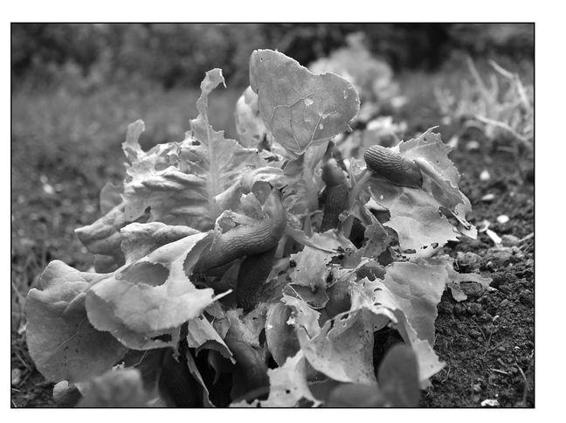
Garden Guru Says
Slugs are nocturnal, so to catch them, you’ll have to go into the garden at night. Use a flashlight, and follow their slimy trails. You can put them in a jar with alcohol, soapy water, or salt to kill them right away. You might want to wear gloves or use large tweezers; otherwise, you’ll get their slime on your hands, and it’s hard to get off.
A hard spray of water is another way to remove insects from leaves and stems. Of course, you can’t do this on tender young seedlings. And if you see suspicious-looking eggs on the backs of leaves, try to wipe them off with a paper towel or even scrape them off with your fingernail and then put them in an airtight bag in the trash.
Organic Sprays
Although not always helpful, some organic sprays do provide some relief from pests. Many of them are made from essential plant oils that allow the spray to adhere to the plants’ leaves.
Oils from mint, cedar, garlic, pepper, citronella, cloves, rosemary, tansy, and many more herbs are sometimes used to repel insects.
Anti-Bug Plants
Some plants have the ability to either attract or repel certain pests. By making the correct planting combinations, you might be able to reduce some of the pest problems in your garden by planting some anti-bug plants in with the plants you know bugs like.
The following table provides a few of the plants you can use to repel or deter harmful insects, or attract beneficial insects.
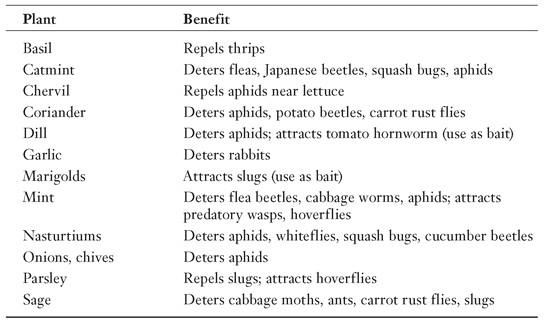
Moles, Voles, and Other Small Critters
First let me say that I am an animal lover. I still stop the car to gaze at a herd of deer at sunset—it’s a beautiful sight. I get a kick out of watching young groundhogs standing on their hind legs as they survey the countryside. And there’s something so gentle and sweet about a wild rabbit nibbling in the lawn.
But critters in the garden are anything but cute. I’ll never forget the sense of rage I felt when, after waiting weeks for the tomatoes to ripen in my New Jersey garden, I ventured out to harvest the first beautiful fruits and every one of them had huge gashes—courtesy of our neighborhood groundhog!
In this section, we look at some of the worst warm-blooded pests, and look at ways to, well, dissuade them. We also discuss some lethal approaches, and I hope any animal rights activists among you will forgive me. I’ve always used the nonkill methods. (Well, I used to have cats that liked to kill voles and the occasional mole.) But I wouldn’t be doing my job if I didn’t offer you as much information as possible.
Voles and Moles
Voles, also called meadow mice, are particularly insidious, and I might add, odious creatures. They are small rodents, ranging from about 3 to 5 inches long. They feast on just about every part of plants, consuming several times their weight every day. Voles can girdle young trees (eat the bark all the way around—a death sentence), devour an entire row of tubers, polish off leaf crops, and generally decimate a garden in a matter of weeks.
Voles live underground but spend a lot of time carrying out their destructive marauding along little aboveground runways. They reproduce at prodigious rates, and the amount of damage they do becomes worse as their numbers increase.
Moles are a different animal altogether, and they are nowhere near as hateful. They range from mouse-size to as much as a foot long, depending on the type. Moles are almost always carnivores. They eat worms, grubs, beetles, ants, and the larvae of other insects. They generally leave plants alone.
In the garden, moles aren’t much of a problem except for the tunnels they dig all over the place that can be used by voles and mice after the moles have left.
Although voles are a real nuisance in the garden, moles aren’t usually such a big deal. Because they eat grubs that will mature into Japanese beetles and other pests, moles can actually perform a service to the gardener.
Food for Thought
I have had some success in discouraging voles and moles from sticking around my garden, although my technique is somewhat gross. I use very soggy and smelly nonclumping kitty litter (with the solids removed). Using a trowel, I pour the litter into the vole and mole holes until I can’t add any more. You can never really fill the holes because the burrows go deep and far. The smell of cat pee must be too much for the voles and moles, and they take a hike. This isn’t a permanent solution, but it can discourage them long enough to keep your crops safe until harvest.
Poison and kill traps are the only sure-fire way to eliminate moles and voles. If you have children or pets, or if your neighbors have children or pets, I would stay away from using poison. Mouse traps work pretty well on voles. Unbaited traps in the runways reduce the population pretty quickly. But again, you won’t want to do this if pets or children spend time in your yard. Special mole traps go deep inside their tunnels. They’re gruesome but effective.
Groundhogs
I know people who think that the only good groundhog is a dead one. I don’t belong to that group. I have nothing against groundhogs … until they come into my garden. That’s when I get out my Havahart trap.
Groundhogs, which are also called woodchucks, marmots, and whistle pigs, are not very bright, so they’re relatively easy to trap.
We trapped an entire family several years ago using a technique suggested by an old timer in the area. We located the main hole of the burrow (in this case it was under our neighbor’s driveway), and placed a trap baited with half an apple directly outside the hole. We set it up so the trap was running in the same direction as the groundhogs when they left their burrow. We caught them one by one over the course of a few days. My husband carted them off to a large meadow a few miles away. (We probably unwittingly broke several laws doing that, but I’m hoping the statute of limitations has passed by now.) By the way, groundhogs smell really bad. It took days for my husband’s car to lose that pungent odor.
Compost Pile
Before you set out to live-trap a wild animal, find out what the animal-control regulations are in your area.
Other ways to deal with groundhogs include shooting them, using kill traps, and fumigating (placing carbon monoxide canisters in the burrows). Most groundhogs do their damage during daylight hours, so some people leave their dogs outside to scare off intruders.
Cute as a Bunny
Admit it, rabbits are really cute. But when they attack your lettuces or go after the spinach, you want to wring their cute little necks. If rabbits are the only pests in your garden, keeping them out isn’t such a difficult task: just put up a fence.
It only needs to be about 2 feet high, and you can use simple wooden stakes and chicken wire around the perimeter. Be sure to tack it down with steel pins, stones, or bricks, or Peter Cottontail and his relatives will find a way to go under.
Here Kitty, Kitty
We are a family of cat lovers. But even the most fanatic of feline fans might take issue when Kitty poops in the garden. It’s just plain disgusting.
If neighborhood cats use your garden as a toilet, you have a couple options. First, keep the hose handy and give Kitty a shower when she sets paw in your space. Cats hate that, and they learn quickly. If she persists, sprinkle cayenne pepper on her favorite spot and she won’t visit again. Neither method will hurt a cat, by the way.
You might also try a diversionary tactic: plant catmint well away from your vegetable garden in a place where visiting cats won’t be a problem. Then watch them get silly.
Deer: In a Class of Their Own
My friend Ian McNeill wages a never-ending war against the deer that invade his backyard garden. On a recent visit to see his intensively planted raised beds, Ian discovered a gaping hole in the netting he’d just installed. The deer were so desperate to get at the young beets that they tore into the netting with their hooves until it split open! Boy, does Ian hate those deer.
And so do most gardeners. At least gardeners who attempt to grow things in the same neighborhood a herd of deer calls home.
But there are solutions. One, of course, is to hunt them. That’s not always an option in the case of suburban communities or in other places that don’t allow hunting, or it might not be a solution that appeals to you. People have also tried …
• Tying aluminum pie pans to poles so they bang against each other in the wind.
• Placing net bags filled with shaved soap or human hair in strategic spots around the garden.
• Spraying the ground around plants or the perimeter of the garden with bobcat, lion, coyote, or fox urine. (I want to know whose job it is to collect that stuff!)
• Playing a recording of shotgun blasts.
• Installing motion detector-activated sprinklers.
• Playing a recording of the 1812 Overture.
• Rigging huge spotlights to shine on the garden all night.
• Spraying a mixture of garlic, cayenne pepper, and canola oil on every last leaf.
• Spreading lion dung around the base of plants.
There are also some commercial products like hot pepper wax and garlic oil spray, along with special dispensers for the coyote and lion urine. Some of these strategies work some of the time. But the truth of the matter is if deer are hungry enough, they will put up with things that scare them like the noise and the predator urine, and with things that smell bad like the cayenne pepper and the garlic oil.
The only really good solution is a barrier, which is almost always in the form of a fence. The key to a successful deer fence is height. Deer are remarkable jumpers, especially if they can get a running start.
I remember a garden in Princeton, New Jersey, with a deer problem that made national news. This garden had two chain-link deer fences, one running parallel to the other but inside the perimeter. The owner of the estate found that a single fence wasn’t enough to keep out the local herd, but that the deer couldn’t cope with the second fence because they couldn’t get that running start. Unfortunately, the place looked like a prison camp.
Dave Benner, whose shade garden in Pennsylvania has been featured in many magazines and books, had such a problem with deer that he developed his own line of plastic mesh deer fencing. It can be up to 10 feet high and is strung between metal
Compost Pile
The electric current that runs through electric deer fencing is not particularly high, but it can hurt a young child. Keep that in mind before you have an electric fence installed.
stakes. Combined with cattle gates at the driveway entrance, it has kept his garden deer free for a decade or more.
The other alternative is an electric fence. This really does keep Bambi and his family out of the garden. Electric fences have become less expensive as demand has increased.
The Least You Need to Know
• Identify the insects in your garden before you take any action.
• Encourage beneficial insects to take up residence in your garden.
• Give organic or natural approaches a try before using commercial pesticides.
• You can use fencing and a number of other tactics to keep warm-blooded animals from destroying your garden.
